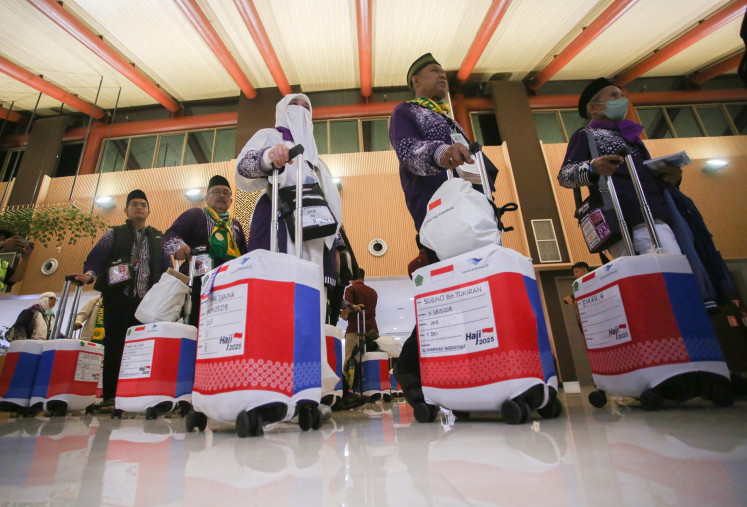Product review: DM-450 keeps important meetings in record
For many years I used an Olympus WS-320M digital recorder in my work
Change text size
Gift Premium Articles
to Anyone

F
or many years I used an Olympus WS-320M digital recorder in my work. It worked very well, although it had some faults, too. The worst had no easy to read indication for remaining battery power. As a result, there were times I went on talking with my interviewees only to find out that part of the conversation was not recorded.
Nonetheless, it was a truly great companion. As it is a dedicated voice recorder, the sound quality is better than what we are likely to get even from an expensive smartphone.
But, very recently, it suddenly refused to power up even after I replaced the battery. Given that a voice recorder is for me like a screwdriver for an auto mechanic, I went to Mangga Dua last week to buy a replacement.
I wrote in this column many years ago that, when it comes to voice recorders, I am a devoted fan of Olympus. I know other top electronics makers such as Sony and Samsung also make great recorders, but I have never thought of jumping the fence. I guess the reason was because my life was made so easy by a microcassette-based Olympus Pearlcorder, which I used to record lectures during the years I studied at the University of Hawaii.
So, once in Mangga Dua Mall, I immediately looked for a store that sold Olympus products. There are plenty of them in that mall, actually. As expected, the WS-320M had been discontinued. I had to look at a newer model and I set my eyes on a Rp 1.75 million (US$1750) DM-450.
The specs were quite attractive, and I can only mention a few details here. The DM-450 has 2 gigabyte internal memory. I can expand it by 512 kilobytes to 16 gigabytes by inserting a MicroSD or MicroSDHC card. As I always copy the files to a PC and even make a backup, I do not see the urgency for additional memory for now. Besides, at the highest quality - the ST XQ - we can record up to 33 hours of interviews.
However, since we can also use this device to store music and downloaded podcasts, there may eventually be a justification for additional memory.
The LCD screen is much larger in the DM-450 compared to my beloved WS-320M, making it easier to read. However, it is the voice assistance that I have found to be very useful as I have low vision. A lady's voice reads aloud which folder I am in, the menu item that I am about to select, for example.
In the WS-320M we only have two levels of microphone directivity zone, i.e. conference to record a speaker's speech and dictation, in the DM-450 we have far more options. First, we can choose the microphone directivity to Zoom, Narrow and Wide, or we can turn it off. Like in the WS-320M, the mic sensitivity level can be set to high, mid or low. A Low Cut Filter will help reduce the noise from background noise.
In the past, I had a couple of interviews in noisy restaurants with music playing in the background. The result was as you can imagine. The hardest thing about every interview is to prepare the transcription, so I usually ask to have the interview in a small and quiet meeting room. Now the Zoom and noise cancellation functions help me.
Olympus has several models including WS-400S that also come with Dragon Naturally Speaking software, a voice recognition that will convert the audio into text. However, since most of my interviews are in Indonesia language, this feature is not as useful.
The rich features of the DM-450 are also complemented by Olympus Sonority software that comes in a CD-ROM. The software allows us not only to manage and playback the files but to erase the part that is not necessary. Incidentally, if you use a voice recorder or a wireless clip microphone often enough, you must have had the experience of entering the restroom and relieving yourself to find out later that you have forgotten to turn the device off. Of course, it is part of the recording that you do not want to share with anyone, and Olympus Sonority can save you from the embarrassment.
Olympus Sonority can also split long recording files to make it smaller and faster to send via email. You can buy a full version, Olympus Sonority Plus, which will give you tools to create MP3 files and even write a CD-R. By the way, the DM-450 can record in MP3 or WMA and play back files in even the pulse code modulation (PCM) mode that will give us a pure audio reproduction.
It seems that the battery cost will be steeper for the DM-450 compared to the WS-320M, as this device requires not one but two alkaline or two NiMH rechargeable batteries. I tried Energizer alkaline batteries, and I barely had 30 minutes to explore the features. To recharge the NiMH, we just need to connect it to our PC via the supplied USB 2.0 cable. However, my experience showed that this would not work if we were using a non-powered, cheap USB hub. I had to connect the USB cable directly to the one in my PC's chassis.
If you have the money, perhaps it is a better idea to go with the 4 gigabyte DM-550. It is a better choice not because it has a larger internal memory but because of the extra features. For example, we can split the recording files on the device, without having first to transfer it to the PC. It also has Intro Play, so you can quickly find the file you want to listen to.
However, so far it seems that the DM-450 already meets my daily needs. I know I still have to carry fully charged spare batteries in my shoulder bag's pocket, but I look forward to several years of good service from this recorder.









